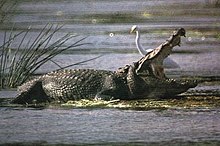Crocodylus
| Crocodylus | |
|---|---|

| |
| C. palustris | |
| Scientific classification | |
| Domain: | Eukaryota |
| Kingdom: | Animalia |
| Phylum: | Chordata |
| Class: | Reptilia |
| Clade: | Archosauromorpha |
| Clade: | Archosauriformes |
| Order: | Crocodilia |
| Family: | Crocodylidae |
| Subfamily: | Crocodylinae |
| Genus: | Crocodylus Laurenti, 1768 |
| Species | |
|
See text | |

| |
| Worldwide distribution of Crocodylus | |
Crocodylus is one of three genera from the subfamily Crocodylinae of the family Crocodylidae.
The 13 living species are:
- American crocodile, Crocodylus acutus
- Slender-snouted crocodile, Crocodylus cataphractus - studies in DNA and morphology suggest this species may be more basal than Crocodylus and therefore belongs in its own genus, Mecistops.[1][2][3][4]
- Orinoco crocodile, Crocodylus intermedius
- Freshwater crocodile, Crocodylus johnsoni
- Philippine crocodile, Crocodylus mindorensis
- Morelet's crocodile or Mexican crocodile, Crocodylus moreletii
- Nile crocodile or African crocodile, Crocodylus niloticus (the subspecies found in Madagascar is sometimes called the black crocodile)
- New Guinea crocodile, Crocodylus novaeguineae
- Mugger crocodile, marsh crocodile, or Indian crocodile, Crocodylus palustris
- Saltwater crocodile or estuarine crocodile, Crocodylus porosus
- Cuban crocodile, Crocodylus rhombifer
- Siamese crocodile, Crocodylus siamensis
- West African crocodile or desert crocodile, Crocodylus suchus
- Crocodylus raninus (Considered as a synonym of Crocodylus porosus, its status remains unclear.[5])
Established species also include six extinct species:[4]
- † Crocodylus anthropophagus is an extinct crocodile from Plio-Pleistocene of Tanzania.
- † Crocodylus bugtiensis is an extinct crocodile from Pakistan
- † Crocodylus checchiai is an extinct crocodile from Late Miocene of Kenya.
- † Crocodylus falconensis is an extinct crocodile from Early Pliocene of Venezuela.
- † Crocodylus palaeindicus is an extinct crocodile the Miocene to the Pleistocene of southern Asia.
- † Crocodylus thorbjarnarsoni is an extinct crocodile from Plio-Pleistocene of Kenya.
Phylogeny
The cladogram below follows the topology from a 2011 analysis of mitochondrial DNA sequences by Robert W. Meredith, Evon R. Hekkala, George Amato and John Gatesy.[3]
| Crocodylus |
| ||||||
The cladogram below follows the topology from a 2012 analysis of morphological traits by Christopher A. Brochu and Glenn W. Storrs. Many extinct species of Crocodylus might represent different genera. C. suchus was not included, because its morphological codings were identical to these of C. niloticus. However, the authors suggested that it could be explained by their specimen sampling, and considered the two species to be distinct.[4]
Evolution
Crocodylus species originated from an ancestor in the Indo-Pacific region between 9 million years ago and 16 million years ago.[6] They radiated into Africa between 8 million years ago and 12 million years ago. This was followed between 4 million years ago to 8 million years ago by a trans-Atlantic migration to the Americas.
References
- ^ McAliley, Willis, Ray, White, Brochu & Densmore (2006). Are crocodiles really monophyletic?—Evidence for subdivisions from sequence and morphological data. Molecular Phylogenetics and Evolution 39: 16-32.
- ^ Brochu, C. A.; Njau, J.; Blumenschine, R. J.; Densmore, L. D. (2010). "A New Horned Crocodile from the Plio-Pleistocene Hominid Sites at Olduvai Gorge, Tanzania". PLoS ONE. 5 (2): e9333. doi:10.1371/journal.pone.0009333. PMC 2827537. PMID 20195356.
{{cite journal}}: CS1 maint: unflagged free DOI (link) - ^ a b "A phylogenetic hypothesis for Crocodylus (Crocodylia) based on mitochondrial DNA: Evidence for a trans-Atlantic voyage from Africa to the New World". Molecular Phylogenetics and Evolution. 60: 183–191. 2011. doi:10.1016/j.ympev.2011.03.026.
{{cite journal}}: Cite uses deprecated parameter|authors=(help) - ^ a b c Brochu, C. A.; Storrs, G. W. (2012). "A giant crocodile from the Plio-Pleistocene of Kenya, the phylogenetic relationships of Neogene African crocodylines, and the antiquity of Crocodylus in Africa". Journal of Vertebrate Paleontology. 32 (3): 587. doi:10.1080/02724634.2012.652324.
- ^ http://reptile-database.reptarium.cz/species?genus=Crocodylus&species=raninus
- ^ Srikulnath K, Thapana W, Muangmai N (2015) Role of chromosome changes in Crocodylus evolution and diversity. Genomics Inform 13(4):102-111. doi: 10.5808/GI.2015.13.4.102
